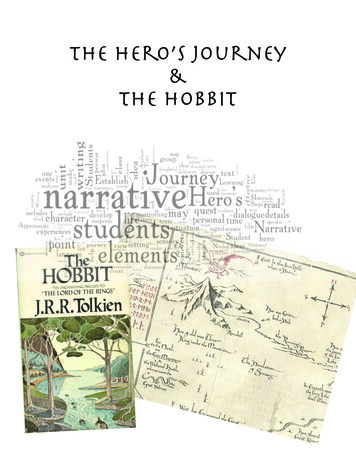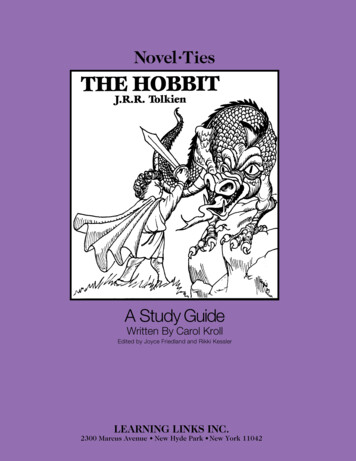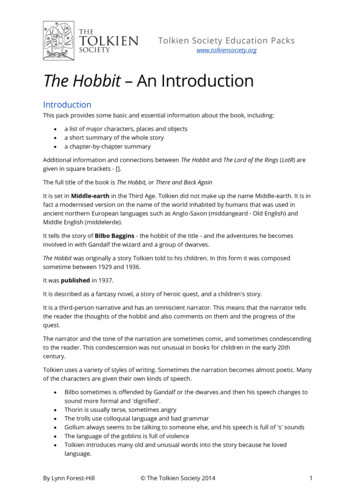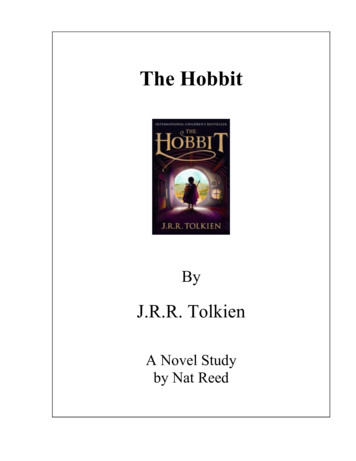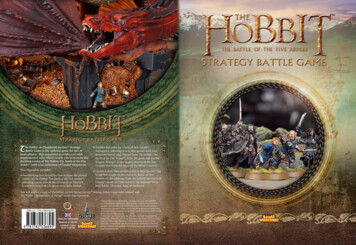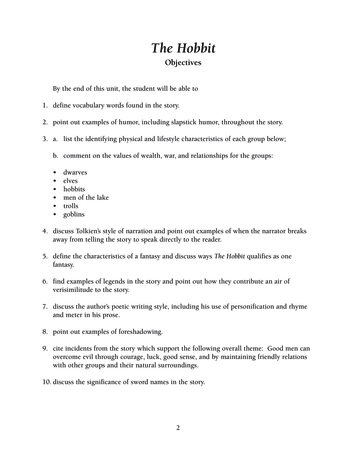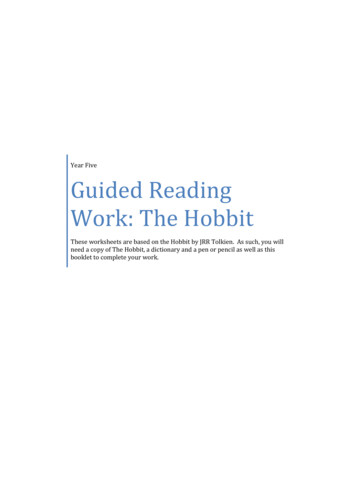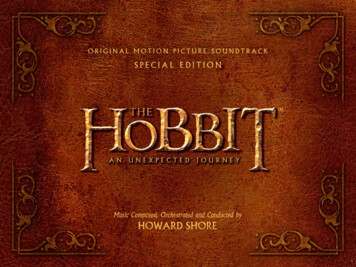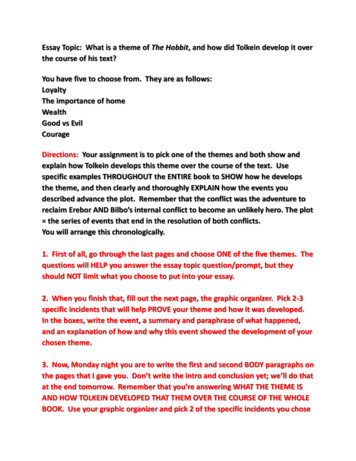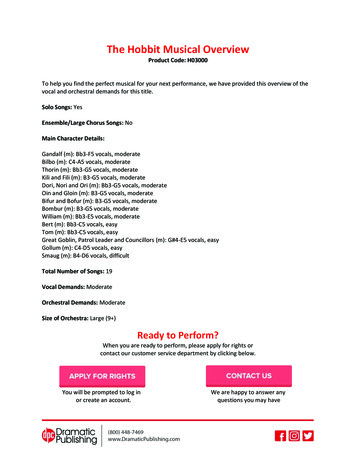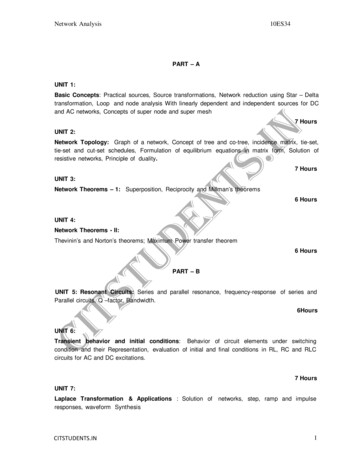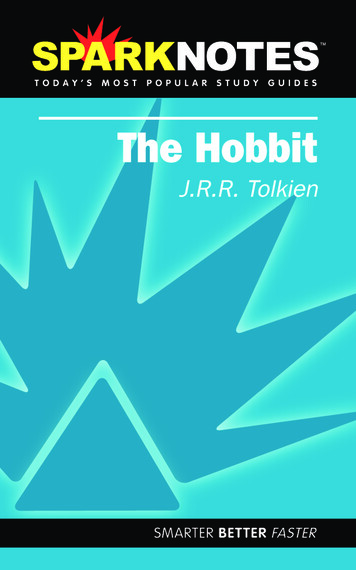
Transcription
the hobbitJ. R. R. Tolkien
technical director Maxwell Krohneditorial director Justin Kestlermanaging editor Ben Flormanseries editors Boomie Aglietti, Justin Kestlerproduction Christian Lorentzenwriters Patrick Gardner, Brian Phillipseditors Sarah Friedberg, Dennis QuinioCopyright 2002 by SparkNotes llcAll rights reserved. No part of this book may be used or reproduced in any mannerwhatsoever without the written permission of the Publisher.sparknotes is a registered trademark of SparkNotes llc.This edition published by Spark PublishingSpark PublishingA Division of SparkNotes llc120 Fifth Avenue, 8th FloorNew York, NY 1001102 03 04 05 sn 9 8 7 6 5 4 3 2 1Please send all comments and questions or report errors tofeedback@sparknotes.com.Library of Congress information available upon requestrrd-cisbn 1401405738
Introduction:stopping tobuy sparknoteson a snowyeveningWhose words these are you think you know.Your paper’s due tomorrow, though;We’re glad to see you stopping hereTo get some help before you go.Lost your course? You’ll find it here.Face tests and essays without fear.Between the words, good grades at stake:Get great results throughout the year.Once school bells caused your heart to quakeAs teachers circled each mistake.Use SparkNotes and no longer weep,Ace every single test you take.Yes, books are lovely, dark, and deep,But only what you grasp you keep,With hours to go before you sleep,With hours to go before you sleep.iii
Contentscontext1plot overview3character listindividual charactersraces557analysis of major charactersbilbogandalfthorin991010themes, motifs & symbolsbilbo’s heroismrace, lineage, and charactercontrasting worldviewsthe nature and geography of middle-earthnamed swordshobbits13131314151515summary & analysischapter 1chapters 2–3chapters 4–5chapters 6–7chapters 8–9chapters 10–11chapters 12–13chapters 14–15chapters 16–17chapters 18–191717202225283133363841iv
important quotations explained45key facts51study questions & essay topics54review & resourcesquiza glossary of terms in the hobbitsuggestions for further reading58586365v
Context1con t e xtJohn ronald reuel tolkien was born on January 3, 1892,in Bloemfontain, South Africa. His parents had moved therefrom England so that his father, Arthur, could work for thebank of Africa. Tolkien lost both parents early in life—hisfather died in Africa in 1896 after the rest of the family hadreturned to England, and his mother, Mabel, died in 1904 near Birmingham, England. After Mabel’s death, Tolkien and his youngerbrother, Hilary, came under the care of Father Francis Morgan, afriend of the family’s. Soon after, Tolkien went to King Edward’sSchool and then to Oxford.At Oxford, Tolkien pursued a degree in English language and literature. He developed a particular passion for philology, the studyof languages. While studying Old English, Anglo-Saxon, and Welshpoetry, he continued experimenting with a language of his own,which he had started to do in his youth. This language would formthe groundwork for his imagined world known as Middle-Earth.By 1916, Tolkien had received his degree and married his childhood sweetheart, Edith Bratt. He eventually took a teaching position at Oxford. By 1929, he had had his fourth child with Edith.During these years, he also began his great mythology of MiddleEarth, a compendium of stories called The Silmarillion. Out of thesestories grew The Hobbit (1936), his first published work. A simplechildren’s story about a small person who takes part in great adventures, the novel’s playful tone and imagery made it a hit with bothchildren and adults. The Hobbit’s success also gave Tolkien a hugepublic that was anxious to learn more about the meticulously developed world that he had created around his invented language andmythology, only a small part of which was detailed in The Hobbit.The Hobbit’s plot and characters combined the ancient heroicAnglo-Saxon and Scandinavian epics Tolkien studied with the middle-class rural England in which he lived. In many ways, the novel’scharm and humor lie in transplanting a simple, pastoral Englishmanof the 1930s into a heroic medieval setting. Tolkien acknowledgedthat his hero, Bilbo Baggins, was patterned on the rural Englishmenof his own time.By the time Tolkien began to work on the sequel to The Hobbit,he had developed a friendship with another well-known Oxford
con t e xt2Hj.r.r. tolkienprofessor and writer, C.S. Lewis, author of The Chronicles of Narnia. Their friendship lasted for many years. Tolkien helped convertLewis to Christianity (although Tolkien, a Roman Catholic, wasdisappointed that Lewis became a Protestant), and the two critiquedeach other’s work as part of an informal group of writers known asthe Inklings.From 1945 to 1959, Tolkien continued to teach at Oxford andwrote The Lord of the Rings trilogy, which served as a follow-up toThe Hobbit. The trilogy brought Tolkien fame in England andAmerica, but he was never a public figure. He continued work onThe Silmarillion and other tales and led a quiet life. Despite his public acclaim, he was most comfortable with middle-class surroundings and peace in which to write and think. Tolkien died onSeptember 2, 1973. The Silmarillion was edited and published posthumously by his son Christopher in 1977.
Plot Overview3p l ot ove rvi ewBilbo baggins lives a quiet, peaceful life in his comfortable hole at Bag End. Bilbo lives in a hole because heis a hobbit—one of a race of small, plump people abouthalf the size of humans, with furry toes and a great loveof good food and drink. Bilbo is quite content at BagEnd, near the bustling hobbit village of Hobbiton, but one day hiscomfort is shattered by the arrival of the old wizard Gandalf, whopersuades Bilbo to set out on an adventure with a group of thirteenmilitant dwarves. The dwarves are embarking on a great quest toreclaim their treasure from the marauding dragon Smaug, and Bilbois to act as their “burglar.” The dwarves are very skeptical aboutGandalf’s choice for a burglar, and Bilbo is terrified to leave his comfortable life to seek adventure. But Gandalf assures both Bilbo andthe dwarves that there is more to the little hobbit than meets the eye.Shortly after the group sets out, two hungry trolls capture all ofthem except for Gandalf. Gandalf tricks the trolls into remainingoutside when the sun comes up, and the sunlight turns the nocturnaltrolls to stone. The group finds a great cache of weapons in thetrolls’ camp. Gandalf and the dwarf lord Thorin take magic swords,and Bilbo takes a small sword of his own.The group rests at the elfish stronghold of Rivendell, where theyreceive advice from the great elf lord Elrond, then sets out to cross theMisty Mountains. When they find shelter in a cave during a snowstorm, a group of goblins who live in the caverns beneath the mountain take them prisoner. Gandalf leads the dwarves to a passage outof the mountain, but they accidentally leave behind Bilbo.Wandering through the tunnels, Bilbo finds a strange golden ringlying on the ground. He takes the ring and puts it in his pocket. Soonhe encounters Gollum, a hissing, whining creature who lives in apool in the caverns and hunts fish and goblins. Gollum wants to eatBilbo, and the two have a contest of riddles to determine Bilbo’sfate. Bilbo wins by asking the dubious riddle, “What have I got inmy pocket?”Gollum wants to eat Bilbo anyway, and he disappears to fetch hismagic ring, which turns its wearer invisible. The ring, however, is thesame one Bilbo has already found, and Bilbo uses it to escape fromGollum and flee the goblins. He finds a tunnel leading up out of the
plot ove rvie w4Hj.r.r. tolkienmountain and discovers that the dwarves and Gandalf have alreadyescaped. Evil wolves known as Wargs pursue them, but Bilbo and hiscomrades are helped to safety by a group of great eagles and byBeorn, a creature who can change shape from a man into a bear.The company enters the dark forest of Mirkwood, and, makingmatters worse, Gandalf abandons them to see to some other urgentbusiness. In the forest, the dwarves are caught in the webs of somegiant spiders, and Bilbo must rescue them with his sword and magicring. After slaying his first spider, Bilbo names his sword Sting.Shortly after escaping the spiders, the unlucky dwarves are capturedby a group of wood elves who live near the river that runs throughMirkwood. Bilbo uses his ring to help the company escape and slipsthe dwarves away from the elves by hiding them inside barrels,which he then floats down the river. The dwarves arrive at LakeTown, a human settlement near the Lonely Mountain, under whichthe great dragon sleeps with Thorin’s treasure.After sneaking into the mountain, Bilbo talks to the sly dragonSmaug, who unwittingly reveals that his armorlike scales have aweak spot near his heart. When Bilbo steals a golden cup from thedragon’s hoard, Smaug is furious and flies out of the mountain toburn Lake Town in his rage. Bard, a heroic archer, has learned thesecret about Smaug’s weakness from a thrush, and he fires an arrowinto the dragon’s heart, killing him. Before Smaug dies, however, heburns Lake Town to the ground.The humans of Lake Town and Elron’s elves of Mirkwoodmarch to the Lonely Mountain to seek a share of the treasure ascompensation for their losses and aid, but Thorin greedily refuses,and the humans and elves besiege the mountain, trapping thedwarves and the hobbit inside. Bilbo sneaks out to join the humansin an attempt to bring peace. When Thorin learns what Bilbo hasdone, he is livid, but Gandalf suddenly reappears and saves Bilbofrom the dwarf lord’s wrath.At this moment, an army of goblins and Wargs marches on themountain, and the humans, elves, and dwarves are forced to bandtogether to defeat them. The goblins nearly win, but the arrival ofBeorn and the eagles helps the good armies win the battle.After the battle, Bilbo and Gandalf return to Hobbiton, whereBilbo continues to live. He is no longer accepted by respectable hobbit society, but he does not care. Bilbo now prefers to talk to elvesand wizards, and he is deeply content to be back among the familiarcomforts of home after his grand and harrowing adventures.
Character ListINDIVIDUAL CHARACTERSGandalfA wise old wizard who always seems to know morethan he reveals. Gandalf has a vast command of magicand tends to show up at just the moment he is neededmost. Though he helps the dwarves in their quest (notleast by making Bilbo go along with them), he does notseem to have any interest in their gold. He always hasanother purpose or plan in mind, but he rarely revealshis private thoughts.Thorin Oakenshield A dwarf who leads his fellow dwarves on atrip to the Lonely Mountain to reclaim their treasurefrom Smaug. Smaug’s bounty is Thorin’s inheritance, asit belonged to Thror, Thorin’s grandfather, the greatKing under the Mountain. Thorin is a proud,purposeful, and sturdy warrior, if a bit stubborn attimes. As the novel progresses, his inability toformulate successful plans, his greed, and his relianceon Bilbo to save him at every turn make Thorin asomewhat unappealing figure, but he is partlyredeemed by the remorse he shows before he dies.5character li s tBilbo Baggins The hero of the story. Bilbo is a hobbit, “a short,human-like person.” Commonsensical and fastidious,Bilbo leads a quiet life in his comfortable hole at BagEnd and, like most hobbits, is content to stay at home.But Bilbo possesses a great deal of untapped innerstrength, and when the wizard Gandalf persuades Bilboto join a group of dwarves on a quest to reclaim theirgold from a marauding dragon, Bilbo ends up playing acrucial role as the company’s burglar. Bilbo’sadventures awaken his courage and initiative andprove his relentless ability to do what needs to be done.
character l is t6Hj.r.r. tolkienGollumA strange, small, slimy creature who lives deep in thecaves of Moria beneath the Misty Mountains. There,Gollum broods over his “precious,” a magic ring, untilhe accidentally loses it and Bilbo finds it. We neverlearn exactly what kind of creature he is. Apparently,his true shape has been too deformed by years of livingin darkness to be recognizable.SmaugThe great dragon who lives in the Lonely Mountain.Years ago, Smaug heard of the treasure that thedwarves had amassed in the mountain under Thror’sreign, and he drove them away to claim the gold forhimself. His flaming breath can scorch a city, his hugewings can carry him great distances, and his armorlikehide is almost impenetrable. Smaug can speak andpossesses a dark, sardonic sense of humor.BardThe grim human who is the honorable captain of theguard in Lake Town, a human city built on Long Lakejust south of the Lonely Mountain. With the help ofinformation discovered by Bilbo and related by athrush, Bard finds Smaug’s weak spot and kills him.BeornA man who can turn into a bear, Beorn helps Bilbo andthe dwarves after their escape from the goblins.ElrondThe great leader of the elves at Rivendell. Elrond givesBilbo’s group aid and helpful advice when they passthrough Rivendell early in the novel. He is described inChapter 3 as being “as strong as a warrior, as wise as awizard, as venerable as a king of dwarves, and as kindas summer.”Dark Lord Sauron An evil sorcerer and creator of the magic ring.Also called the Necromancer, Sauron is onlymentioned in The Hobbit; he never actually appears.
the hobbitThrorH7Thorin’s grandfather. Thror mined Moria, a series ofcaves under the Mountain, and discovered a wealth ofgold and jewels. He became King under the Mountain,but before long, the dragon Smaug came and killed orscattered all of Thror’s people. The dragon has beenguarding the treasure ever since, and Thorin wants toget back what is rightfully his.Dwarves Thorin’s group, composed of Fili, Kili, Dwalin, Balin,Oin, Gloin, Ori, Dori, Nori, Bifur, Bofur, and Bombur,none of whom is really developed as an individualcharacter in the novel. The narrator describes dwarvesunfavorably in Chapter 12, noting their greed andtrickery. Some, however, are “decent enough peoplelike Thorin and Company, if you don’t expecttoo much.”ElvesThe first creatures in Middle-Earth. Immortal unlesskilled in battle, they are fair-faced, with beautifulvoices, and have a close communion with nature,which makes them wonderful craftsmen. There areactually two different varieties of elves: the wood elvesand the high elves. The wood elves reside in Mirkwoodand, as a result, have more suspicious and less-wisetendencies than their high relatives.HumansHumans appear in the settlement of Lake Town nearthe Lonely Mountain. Tolkien emphasizes theirmortality, their lack of wisdom, their discordance withnature, and their rampant feuding, but he does notdescribe humans as inherently evil in the same way thathe characterizes goblins and Wargs.character li s tRACES
character l is t8Hj.r.r. tolkienTrollsShort-tempered and dull-witted creatures who will eatjust about anything, the trolls are based onmythological creatures taken from Old English andAnglo-Saxon poems and on figures from popular fairytales and folklore. Tolkien has them speak with acockney accent, the dialect of lower-class Londoners,which injects a modern joke into the fantasy epic.GoblinsEvil creatures encountered by Bilbo and company inChapter 4. Goblins are infamous for their ability tomake cruel weapons and torture devices.WargsEvil wolves who join forces with the Goblins at theBattle of the Five Armies in Chapters 17 and 18. TheWargs haunt and pursue Bilbo and the dwarves soonafter Bilbo acquires the ring.
Analysis of MajorCharactersBILBO9character analys i sThe protagonist and title character of The Hobbit, Bilbo is by far thenovel’s most important figure. Bilbo’s thoughts, feelings, andactions form the focus of the novel and shape its plot. Bilbo’s centralrole is underscored by his appeal—he is not only the most importantbut also the most likable and honorable character. Even as the otherparticipants in his quest become corrupted by greed, Bilbo maintains his common sense, courage, and eagerness to please.Bilbo’s understated charisma is a quality common to many protagonists in children’s literature. Another quality he shares withmany heroes of children’s literature is his small size: as a hobbit,Bilbo is only half the size of a man. At the beginning of the novel,Bilbo is, like most hobbits, comfortable and complacent. He lovesfood, drink, and security, and he relishes his snug little hole at BagEnd, Underhill. But as Gandalf says, there is more to Bilbo thanmeets the eye. Bilbo is a Baggins, the heir of a thoroughly respectableand conventional family, but his mother was a Took, an eccentricclan of hobbits noted for their love of excitement and adventure.When Gandalf enlists Bilbo’s help in Thorin’s quest for the treasure under the mountain, Bilbo begins a process of gradual development, transforming from a cautious homebody at the beginning ofthe novel to a brave and confident hero at the end. As the questprogresses, Bilbo shows a vast reserve of inner cunning and strengthand slowly becomes the dominant force holding the group of haplessdwarves together. He saves them from the goblins by shouting forGandalf, he rescues them from spiders and wood elves in Mirkwood,he finds the way into the mountain, he leads them to the treasure, hediscovers Smaug’s weak spot, and he attempts to thwart Thorin’sgreed and to bring peace to the feuding dwarves, elves, and humans.Bilbo’s heroic deeds are all the more remarkable because theyfail to change him. He discovers capabilities that had beenunknown to him, but he does not become arrogant or relinquishhis values. In his final conversation with Bilbo, Thorin acknowl-
10Hj.r.r. tolkienedges the value of the simple lives of hobbits, even in a worldmarked by grim heroism and danger. Though Bilbo learns tothrive in this outer world, he draws strength from the simplesource that guided his heroic quest. His decision to return to Hobbiton toward the end of the novel indicates that, despite his newfound heroism, Bilbo has stayed true to himself all along.character analysisGANDALFThough his history and character are more fully explored in TheLord of the Rings and The Silmarillion, Gandalf remains a loomingmystery in The Hobbit, a constant reminder that Middle-Earth ismore vast and cryptic than Bilbo realizes. A powerful wizard, Gandalf generally prefers to keep his powers and motives closelyguarded. He never reveals, for instance, why he chooses to helpThorin in his quest; he certainly has no interest in the treasure, andhe leaves the company in Mirkwood while he goes to fight againstthe Necromancer. Something both inspiring and dangerous definesGandalf’s character—he is an unshakable bulwark against evil, andyet he seems to have an enlightened, almost godlike knowledge ofevery person’s place in the world.Gandalf’s sweeping, epic personality separates him from the vastmajority of characters that commercial fantasy literature has produced in the decades since The Hobbit was first published. ThoughGandalf can be viewed as the source of the stereotypical figure offantasy wizard, Gandalf himself is more than just an old man withpowerful spells and a pointy hat. Tolkien imbues Gandalf with asense of heightened awareness, ensuring that Gandalf alwaysknows more about what is happening than we do, even when theother characters are left in the dark.THORINThe leader of the dwarves who embark on the treasure quest inChapter 2, Thorin is in many ways a typical member of his race:brave, stubborn, proud, and greedy for gold. Though his birthrightand noble bearing initially make Thorin seem like a fairly heroic figure, the dwarf’s status quickly declines as Bilbo’s rises. Soon afterGandalf leaves the party, it becomes apparent that Thorin is not atrue leader: he is incapable of formulating a plan, makes hasty andpoor decisions, and generally relies on Bilbo to see him through his
the hobbitH11adventures, all the while treating Bilbo like an insignificant underling. Once Thorin gets his hands on Smaug’s treasure, he becomesirrationally greedy and obsessed with wealth, to the extent that hewould rather wage a violent war than give the men from Lake Towntheir fair share of the treasure. Thorin is partially redeemed by hisdying apology to Bilbo, but not even this act of remorse can fullyredeem him. In general, the arrogant Thorin works as a foil for theunassuming Bilbo, setting off Bilbo’s best qualities and creating aleadership void that provides Bilbo the chance to seize the initiativeand become a true hero.character analys i s
Themes, Motifs &SymbolsTHEMESThemes are the fundamental and often universal ideas exploredin a literary work.Bilbo’s HeroismRace, Lineage, and CharacterThe differences among Tolkien’s imaginary races are a major focusof the novel, particularly in its second half. Elves, dwarves, trolls,13themesThe Hobbit’s main theme is Bilbo’s development into a hero,which more broadly represents the development of a common person into a hero. At the beginning of the story, Bilbo is timid, comfortable, and complacent in his secure little hole at Bag End. WhenGandalf talks him into embarking on the quest with Thorin’sdwarves, Bilbo becomes so frightened that he faints. But as thenovel progresses, Bilbo prevails in the face of danger and adversity,justifying Gandalf’s early claim that there is more to the little hobbit than meets the eye.Bilbo possesses hidden reserves of inner strength that even Bilbohimself cannot perceive when he firsts sets out on the quest. Confronting the trolls, escaping with Gollum’s ring, slaying the spider,rescuing the dwarves in Mirkwood, and speaking face-to-face withthe great dragon Smaug all provide Bilbo with opportunities to testhis resolve. As he builds confidence and resourcefulness, Bilboemerges as a true hero.Because Tolkien acknowledged that the idea of hobbits wasrooted in his experiences with rural Englishmen of his own time,Bilbo’s development might allegorically represent the heroism ofEngland in World War I or the inner, latent heroism common toeveryone. But given Tolkien’s stated distaste for allegory—his mainmotivation for writing was storytelling, not the exploration of a literary theme—it is questionable whether Bilbo’s story should betaken to refer to anyone except Bilbo himself.
moti fs14Hj.r.r. tolkienand goblins differ from one another physically, psychologically, andmorally. These inherent racial differences drastically limit the possibility of individual choice but make moral distinctions easy to maintain. All goblins are evil, for example, and all elves are good. Thenotion of races having different moral qualities is reflected in thenovel’s idea of nature. The good races are portrayed as being in harmony with nature, while the evil races are depicted as being at oddswith it—hence the eagles’ decision to help the elves against the goblins. Some critics have suggested that the different races in The Hobbit were meant to represent different European nationalities, butTolkien’s distaste for allegory makes this seem highly unlikely.Family lineage is another important factor that shapes identity inThe Hobbit. Throughout Middle-Earth, one’s prospects, character,and social position are linked closely to family heritage. Bilbo’s conflicting feelings of fear and courage, for instance, are portrayed as astruggle between his Baggins side and his Took side, referring respectively to his father’s and his mother’s families. Thorin is prompted toseek the treasure under the mountain because it is his birthright,passed down from his grandfather, Thror. Bard’s heroism is in partattributed to his having descended from the lords of Dale. Whereasrace is primarily a determinant of one’s moral standing, family hasmore to do with one’s specific personality: Bilbo is good because heis a hobbit, but he is adventurous because he is a Took.MOTIFSMotifs are recurring structures, contrasts, or literary devicesthat can help to develop and inform the text’s major themes.Contrasting WorldviewsTolkien was a scholar of ancient languages at Oxford. A majorsource of inspiration for The Hobbit’s plot was the body of ancientepic literature that Tolkien studied, particularly Scandinavian andAnglo-Saxon epics like Beowulf. Elements of the story originatefrom literature, including the form of the heroic quest, the dragon’streasure hoard, the importance of named swords, the elves’ mysterious magic, and the grim focus on birthright and family lineage.The Hobbit revisits many of these ancient conventions with aplayful, comic tone that is thoroughly modern. Bilbo himself, withhis common sense, love of peace, and warmhearted self-doubt, is inmany ways a rural Englishman of the 1930s transplanted into a
the hobbitH15medieval adventure. Tolkien’s exploration of this contrast betweenthe world in which he lived and the worlds he studied is the source ofa large part of the book’s comedy. This contrast also has some thematic importance—Thorin’s last words to Bilbo indicate thatdespite the grandeur of epic heroism, the simple modern values ofthe hobbits perhaps have a more important place in the world.The Nature and Geography of Middle-EarthSYMBOLSSymbols are objects, characters, figures, or colors used torepresent abstract ideas or concepts.Named SwordsThroughout epic literature, swords with names and lineages are themarks of great heroes. One of the most famous examples is KingArthur’s sword, Excalibur. The swords named Orcrist and Glamdring that Thorin and Gandalf win from the trolls symbolize theirheroic deeds. Bilbo’s decision to name his short sword Sting after killing the spider is a major turning point in his quest—it symbolizes hisbravery and initiative, and presages his transformation into a hero.HobbitsThough the thematic importance of hobbits is highly debatable,Tolkien himself acknowledged that the nature of hobbits was basedon the rural, middle-class English people among whom he lived.This symbol enables Tolkien to explore the contrast betweenancient and modern worldviews as the modern-minded Bilbo travels the ancient world of Middle-Earth.s ymbolsSince The Hobbit takes place in a world of the author’s own creation—complete with its own history, language, geography, andmythology—much of the narrative is devoted to incidental descriptions of the places, people, and things that Bilbo encounters. As aresult, Middle-Earth emerges as a finely detailed reality with a convincing visual presence and its own unique atmosphere. Taking thereader through this world is one of the primary considerations of thenovel, and a great part of Tolkien’s literary ingenuity is devoted tomaking Middle-Earth seem as real as possible. For many readers,experiencing Middle-Earth as a self-contained whole is probablythe most striking aspect of reading The Hobbit.
Summary & AnalysisC H A P T E R 1: A N U N E X P E C T E D P A R T YThere is a lot more in him than you guess, and a dealmore than he has any idea of himself.(See quotations, p. 45)Summary17s ummary & analys i sHobbits, the narrator explains, are little people, roughly half thesize of humans, with thick hair on their feet, round bellies, and alove of good food, comfort, and security. Though some hobbits livein houses, they traditionally live in holes in the ground. The holesare not dank and smelly but comfortable, cozy underground dwellings with all the amenities of their aboveground counterparts. Thehole occupied by the hobbit known as Bilbo Baggins is called BagEnd. It is quite a pleasant dwelling, with comfortable furniture anda well-stocked kitchen, nestled in a snug little village under a hill.Bilbo’s ancestry is somewhat noble by hobbit standards: hisfather was from the well-to-do, conventional Baggins family, but hismother was from the Tooks, a wealthy, eccentric family infamous fortheir unhobbitlike tendency to go on adventures. Despite his Tookblood, however, Bilbo prefers to stay at home and live a quiet life.On the day the story begins, Bilbo is enjoying a pipe outside hisfront door when an old man with a long cloak and a staff arrives.After the old man introduces himself, Bilbo recognizes him as thewizard Gandalf, who has created spectacular fireworks displays onholidays in Hobbiton, but Bilbo still looks on the old wizard with asuspicious eye. When Gandalf asks if Bilbo would be interested ingoing on an adventure, Bilbo declines and quickly excuses himself.He invites the wizard to come over for tea sometime but only so asnot to seem rude—in reality, he wants nothing to do with Gandalfand his adventures.When the doorbell rings the next afternoon, Bilbo assumes it isGandalf. To his surprise, a dwarf named Dwalin pushes past himand promptly sits down to eat. Soon, other dwarves begin to arrive,and as Bilbo’s neat little home becomes crowded with dwarves,Bilbo becomes increasingly confused and annoyed. At last, Gandalf
s ummary & analys i s18Hj.r.r. tolkienarrives with the head dwarf, Thorin. The thirteen dwarves and thewizard nearly clean out Bilbo’s pantry before finally settling downto discuss their business.It soon becomes clear that Gandalf has volunteered Bilbo to be a“burglar” for the dwarves on their adventure. The hobbit protests,and the dwarves grumble that the soft little hobbit does not seemsuited to their adventure. Gandalf, however, is certain that Bilbo isuseful, and insists that there is more to the hobbit than meets the eye.The wizard then brings out an old map of a great mountain andpoints to a mysterious secret entrance, a door to which Thorin holdsthe key. Bilbo demands some clarification about the point of thewhole expedition. Thorin explains that his grandfather, Thror,mined the mountain shown on the map and discovered a wealth ofgold and jewels. Thror then became King under the Mountain, buthis fantastic treasure attracted unwanted attention. Before long, thedragon Smaug came an
The Hobbit (1936), his first published work. A simple children’s story about a small person who takes part in great adven-tures, the novel’s playful tone and imagery made it a hit with both children and adults. The Hobbit ’s success also gave Tolkien a huge public tha

